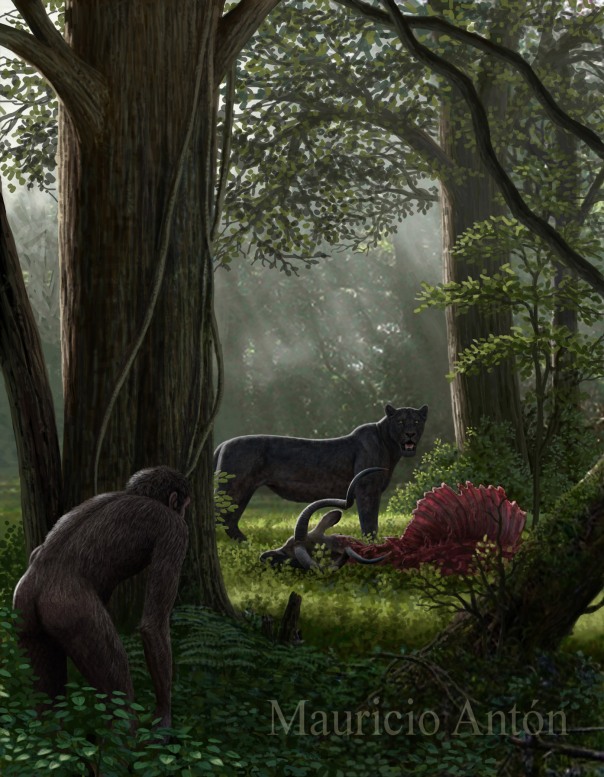Spying on the big cats: an ancestral occupation
Prey animals are often quite interested in their predators. If you have spent time in the African wilderness you may have seen how the antelopes seem to shadow a leopard that ventures out from cover. The herbivores apparently consider that the most dangerous predator is the one that you can’t see, so they always try to keep the big cats in sight.
For our own ancestors, curiosity about the predators was a more complex thing. The very earliest hominins were almost exclusively vegetarian so they fit the role of potential prey very well. Fascination for the big cats equaled fascination with danger, a danger you need to know in order to better avoid it.
But, just as modern chimpanzees now and then include some monkey in their diet, australopithecines were likely to have more than a passing interest in meat, and from that point on, the felids became even more interesting, as examples of an extremely efficient fellow predator.
Somewhere in a humid forest in Southern Africa, a hominid of the species Australopithecus africanus spies on a melanic specimen of the “false sabertooth” Dinofelis barlowi, feasting on its kudu kill

Then another big change happened in our hominin ancestors’ behavior. Not content with an ocassional taste of meat, they became regular scavengers, a development inseparable from their ability to shape the kind of stone tools that allowed them to deflesh and break the bones of animals. From that point on, sabertooth cats and other big predators became potential providers of fresh carcasses, and hominins needed to become ever more acquainted with the details of their behavior, not only in order to predict when and where to look for their kills, but also to avoid becoming new kills themselves during the process of stealing.
Perhaps it is not surprising that when modern humans developed the ability to create art, the first subject they turned their attention to were the big cats. Learning about the felines was a way to know nature (and human nature) in more depth. To this day, drawing the big cats is an unsurpassed way to grasp the secrets of what it means to be alive in this world. I for one never tire of it, and it is good to know that my passion has such a long pedigree. If I am a freak, at least I am in good company!
Posted on 07/02/2017, in Uncategorized. Bookmark the permalink. 6 Comments.
Looks like that fellow’s getting himself into some serious danger. No one spies on Bagheera and lives to tell the tale.
In all seriousness though I like this piece. The lighting, the shadows, the colour and the subjects in focus are all really well done and detailed. Excellent work! 🙂
You sai d it; he is getting into big trouble
Con todo, este es el mejor paleoart que he visto en toda mi vida. ¡Trabajo asombroso!
Do you think that you may do a blogpost on the Martelli’s cat, the ancestor of the wildcat (Felis silvestris), sometime?
What is your opinion and position on the five subspecies of the wildcat?
1) European Wildcat (silvestris subspecies; includes Scottish, Caucasian, and Spanish variants)?
2) Near Eastern Wildcat (lybica subspecies; includes Gordon’s and domestic variants)?
3) Southern African Wildcat (cafra subspecies; includes Kalahari variant)?
4) Central Asian Wildcat (ornata subspecies)?
5) Chinese Mountain Cat (bieti subspecies)?
Here is my blog focusing on the wildcat species as a whole and its different subspecies and ecotypes.
Wildcats: https://nebbiewildcatsblog.wordpress.com
Howdy. Do you think you may a blogpost on *Lokotunjailurus fanonei soon**?*
On Fri, Feb 17, 2017 at 7:02 PM, chasing sabretooths wrote:
> nebbie916 commented: “Do you think that you may do a blogpost on the > Martelli’s cat, the ancestor of the wildcat (Felis silvestris), sometime? > What is your opinion and position on the five subspecies of the wildcat? 1) > European Wildcat (silvestris subspecies; includes Scot” >
This image is a wonderful combination of tranquility and tension, a very unique mixture. I tried a similar piece last year, and it looks like I have a long way to go. You have knack for putting your viewers in the place of our predecessors; you are not a freak, rather a master artist!